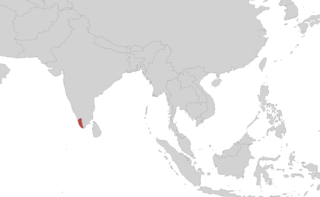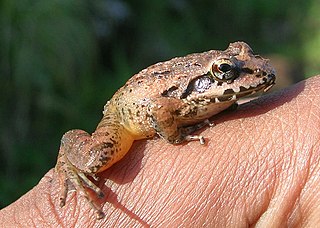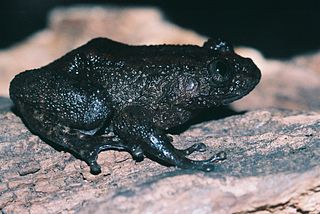 W
WBlythophryne is currently a monotypic genus of true toads described from the Andaman Islands, in the Bay of Bengal, India. It is about 24 millimetres (0.94 in) long.
 W
WThe Bombay caecilian is an amphibian found in India. This rather large species is found in the northern Western Ghats. The eyes are distinct and surrounded by a light ring. The tentacle is placed closer to the lip than the eye. A dark brown or greyish-brown species, it has no lateral stripes.
 W
WThe Western Ghats in India are home to several species of caecilians (Gymnophiona). Caecilians are legless, burrowing amphibians which mostly live in leaf litter, loose soil, under rocks and decaying logs. They are also found in agricultural fields and only surface during the monsoon. The body is elongated and smooth with a slimy skin. The smaller caecilians superficially resemble earthworms while the larger ones are often mistaken for snakes. However, they can be told apart from earthworms by the presence of eyes, teeth and skeleton and from snakes by the lack of scales on skin. The eyes in caecilians are not well developed which is most likely to be because of their burrowing life style. They are considered as rare which is apparently due to their subterranean habits. To see them one has to search carefully and be at the right place and at the right time. There are few places where they are common, but, at least one species was reported to be abundant in agricultural fields in Kerala. The larger caecilians can resemble snakes, but their skin is smooth, not scaly.
 W
WIchthyophis beddomei is a species of caecilian in the family Ichthyophiidae. This species is distributed widely in the Western Ghats in southern India. The nominal species might be a composite of several cryptic species. It is also known as the yellow-striped caecilian, Beddome's caecilian, or Nilgherries caecilian.
 W
WIchthyophis garoensis, the Garo Hills caecilian, is a species of caecilian found in Assam and Meghalaya in north-eastern India. The Husain's caecilian Ichthyophis husaini was until 2016 considered a separate species. It is a subterranean caecilian that lives in the moist leaf-litter of tropical forests. It is typically found close to streams and other waterbodies.
 W
WIchthyophis kodaguensis, also known as the Kodagu striped Ichthyophis, is a species of caecilian in the family Ichthyophiidae. It is endemic to the southern Western Ghats, India. All confirmed records are from southern Karnataka state, although it is also reported from adjacent Kerala.
 W
WIchthyophis longicephalus, the long-headed caecilian, is a species of caecilian in the family Ichthyophiidae. The body is dark violet-brown, and lighter ventrally. A yellow lateral stripe starts at the neck and reaches the tip of the tail. Small, yellow patches are also found on the sides of the neck. A midventral line formed by the breaking of annulli ventrally extends from the neck to the vent. The long head has distinct eyes, and the tentacles are close to the lip and eye. The nostrils are at the tip of the snout and visible from above. The upper jaw overhangs the lower jaw. The species is found in Kerala.
 W
WIchthyophis sikkimensis, the Sikkimese caecilian or Darjeeling caecilian, is a species of caecilian found in India, Nepal and possibly Bhutan. It was described by Edward Harrison Taylor in 1960.
 W
WIchthyophis tricolor, the three-colored caecilian or Maddatorai caecilian, is an amphibian endemic to the Western Ghats, India. Its taxonomic status is unclear, including its relationship with Ichthyophis beddomei and the possibility of cryptic species.
 W
WIndirana is a genus of frogs in the family Ranixalidae. These frogs are endemic to the Western Ghats of India. They are sometimes known under the common name Indian frogs, whereas members of their parent family are named "leaping frogs".
 W
WMicrixalus is a genus of frogs from that are endemic to the Western Ghats in India. They are monotypic within the family Micrixalidae. Before being raised to the family level they were classified as the subfamily Micrixalinae within Ranidae. Micrixalus frogs are popularly known as "dancing frogs" due to their peculiar habit of waving their feet to attract females during the breeding season. Dancing frogs are extremely vulnerable as their habitat is severely threatened.
 W
WNyctibatrachus is a genus of frogs endemic to the Western Ghats of southwestern India. Their common name is night frogs. Their scientific name also means "night frog", in reference to their habits and dark color. They are the only extant members of the monotypic subfamily Nyctibatrachinae.
 W
WThe Seychelles frogs (Sooglossidae) are a family of frogs found on the Seychelles Islands. Until recently, this family was believed to include the genera Sechellophryne, Nesomantis and Sooglossus, but following a major revision of amphibians in 2006, the genus Nesomantis was named a junior synonym of Sooglossus. Their closest relatives are the purple frogs (Nasikabatrachidae) of India.
 W
WTylototriton verrucosus is a species of newt found in the Indian subcontinent and Southeast Asia. Common names include: Himalayan newt, crocodile newt, crocodile salamander, Himalayan salamander, red knobby newt.
 W
WUraeotyphlus interruptus, also known as the Chengalam caecilian, is a species of caecilian in the family Ichthyophiidae. It is endemic to the Western Ghats in southern India and is only known from its type locality, Chengalam village in Kerala.
 W
WUraeotyphlus menoni, also known as Menon's caecilian or Kerala caecilian, is a species of caecilian in the family Ichthyophiidae. It is endemic to the state of Kerala in the Western Ghats, India. The specific name menoni honours K. Ramunni Menon, collector of the holotype who later became the vice-chancellor of the University of Madras.
 W
WUraeotyphlus narayani, or Narayan's caecilian, is a species of caecilian endemic to the Western Ghats of India.
 W
WUraeotyphlus oxyurus, also known as the red caecilian, sharp-nosed caecilian, dark-brown caecilian, pale-throated caecilian, or harp-tailed caecilian, is a species of caecilian in the family Ichthyophiidae. It is endemic to the Western Ghats in Kerala and Tamil Nadu, southern India.